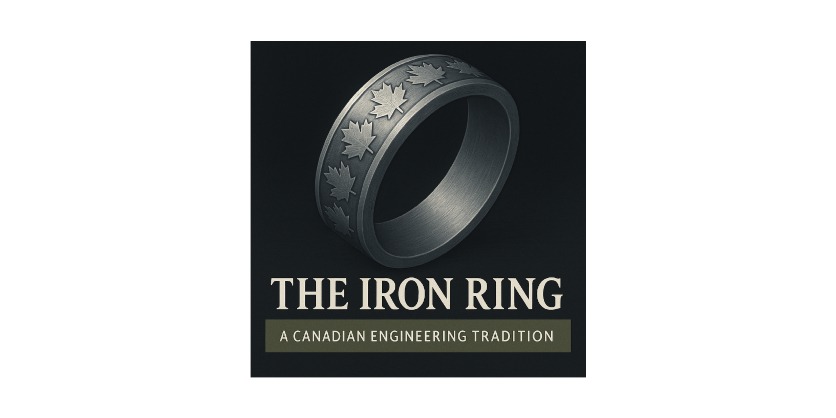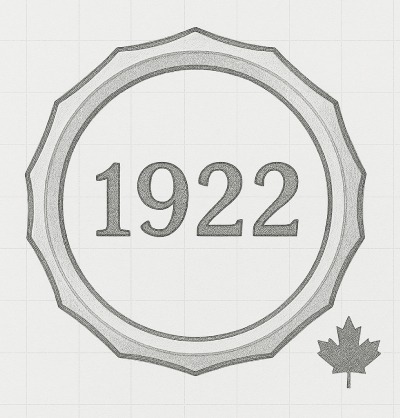The Iron Ring: Canadian Engineering’s Enduring Symbol of Duty
April 16, 2025

In Canada, engineers wear a simple, unornamented ring of stainless steel or iron on the pinky finger of their dominant hand. To most, it might seem understated — but within the Canadian engineering community, the Iron Ring carries deep meaning. It symbolizes a lifelong commitment to ethics, humility, and the professional responsibility engineers hold in shaping the world around them.
The Iron Ring is not a certification, and it’s not a credential. It’s a promise — one made quietly but never taken lightly.
Origins Rooted in Responsibility

The Iron Ring tradition was first proposed in 1922 by a group of seven past presidents of the Engineering Institute of Canada. They believed that Canadian engineers needed a lasting symbol to reinforce the moral and professional obligations they carry — a reminder that their work directly affects public safety, infrastructure, and human lives.
That belief was deeply influenced by one of the most tragic engineering failures in Canadian history: the collapse of the Québec Bridge. The bridge collapsed twice during construction — first in 1907 and again in 1916 — resulting in the deaths of a total of 88 workers.
The disasters were caused by critical design flaws and ignored warnings from junior engineers, highlighting a catastrophic failure in both technical oversight and ethical responsibility.
In response, Canadian engineering leaders sought a way to instill a stronger sense of professional duty in future generations of engineers. Their efforts led to the creation of the Ritual of the Calling of an Engineer, a private ceremony first held in Montreal in 1925.
The structure and tone of the ritual were developed with assistance from British author Rudyard Kipling, who was known for his deep respect for craftsmanship and duty. Kipling contributed oaths and readings that emphasize humility, service, and accountability — many of which are still used in ceremonies today.
Although the ritual does not explicitly mention the Québec Bridge disaster, the tragedy served as a formative backdrop for its creation. The Iron Ring itself — originally made of wrought iron — was intended to symbolize the weight of the engineer’s responsibility.
Rather than a celebration, the ritual serves as a solemn call to action: a reminder that engineering is not just about solving problems, but doing so with integrity, care, and awareness of the human impact behind every calculation and design.
What the Iron Ring Means
The Iron Ring is offered to engineering graduates during the Ritual of the Calling of an Engineer. Administered by the Corporation of the Seven Wardens, the ceremony is solemn and symbolic. It’s attended by graduates and their mentors — engineers who have themselves worn the ring, often for decades.
The ring is worn on the pinky finger of the dominant (working) hand, so it comes in contact with drawings, designs, and tools — serving as a subtle, physical reminder of the responsibilities that come with engineering work.
It represents a commitment to:
- Prioritize public safety above personal or commercial interests
- Practice with honesty, diligence, and humility
- Accept accountability for engineering decisions
- Approach each task with care, knowing lives and livelihoods may depend on it
It is not enforced by law. No governing body can revoke it. Its power lies in the shared understanding among Canadian engineers: that this profession is bound not just by science and math, but by ethics and trust.
Electromate: Built on Canadian Engineering Values
Electromate is proud to be 100% Canadian-owned and operated, with engineering teams located in all major markets across the country. Their staff includes electrical, mechanical, and mechatronic engineers who hold degrees from Canadian institutions and carry decades of experience. Many of them wear the Iron Ring — and carry forward its values in the automation and motion control solutions we provide every day.
Electromate does not just distribute parts — they bring together technical experts from multiple disciplines to collaborate on custom solutions. That collaborative spirit is a direct reflection of Canadian engineering culture: practical, ethical, and deeply committed to problem-solving.
With current tariff pressures reshaping the international landscape, more Canadian businesses are recognizing the value of working with Canadian-owned companies like Electromate. For them, it’s about more than geography — it’s about accountability, integrity, and the engineer’s promise to always act in the public interest.
Did You Know? Interesting Facts and Myths About the Iron Ring:
- It’s not made of iron anymore. – The earliest rings were made of wrought iron, but most today are stainless steel for durability. Some engineers still request an iron version for its symbolic weight.
- You must attend the ceremony to receive the ring. – Rings are only conferred during the Ritual of the Calling of an Engineer. You can’t buy one, and you can’t wear someone else’s.
- It’s not the same as a P.Eng designation. – The Iron Ring is symbolic, while the P.Eng is a legal credential granted by a provincial or territorial engineering association.
- The Québec Bridge story isn’t official. – While the disaster had a major influence on Canadian engineering safety standards, the Iron Ring ritual doesn’t formally mention the event.
- You can re-attend the ceremony. – Engineers who want to recommit to their values can request to take part in future ceremonies — often alongside a new generation of engineers they’re mentoring.
- Mentorship is central to the tradition. – Many engineering graduates are presented their rings by mentors or family members who are engineers themselves, reinforcing a sense of intergenerational responsibility.
More Information
Related Story
Electromate: Tariff-Free Automation Products in Canada
At Electromate, they understand how recent tariff policies have impacted the cost and availability of automation components across North America. That’s why they have made it easier for Canadian manufacturers, OEMs, and system integrators to source tariff-free mechatronic and robotic automation components.
They are a Canadian-owned and operated company with representation and technical support across the country. Their product portfolio includes a growing list of high-quality, globally respected manufacturers whose products are not subject to tariffs when purchased in Canada.

